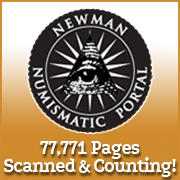
About UsThe Numismatic Bibliomania Society is a non-profit organization devoted to the study and enjoyment of numismatic literature. For more information please see our web site at coinbooks.org SubscriptionsThose wishing to become new E-Sylum subscribers (or wishing to Unsubscribe) can go to the following web page link MembershipThere is a membership application available on the web site Membership Application To join, print the application and return it with your check to the address printed on the application. Membership is only $20 to addresses in the U.S., $25 for First Class mail, and $30 elsewhere. For those without web access, write to: Terry White, Treasurer
AsylumFor Asylum mailing address changes and other membership questions, contact Terry at this email address: terrywhite5475@yahoo.com SubmissionsTo submit items for publication in The E-Sylum, just Reply to this message, or write to the Editor at this address: whomren@gmail.com BUY THE BOOK BEFORE THE COINSale Calendar |
- WAYNE'S WORDS: THE E-SYLUM DECEMBER 20, 2015
- KOLBE & FANNING EXPANDING OHIO OFFICES
- NEWMAN NUMISMATIC PORTAL SPONSORS SCANNING AT ANS
- ANS PARTICIPATES IN HUMANITIES OPEN BOOK PROJECT
- NEW BOOK: FRENCH COINAGE SPECIFICALLY FOR COLONIAL AMERICA
- NEW BOOK: COIN OF THE CANONICAL REALM
- BOOK REVIEW: COIN COLLECTORS SURVIVAL MANUAL, 7TH ED.
- COURTNEY COFFING (1920-2015)
- ANA LAUNCHES NEW EDUCATIONAL VIDEO SERIES
- COINWEEK UPGRADES VIDEO, INTRODUCES PODCAST
- MISSING MANCHESTER MUSEUM COIN REGISTER SOUGHT
- MORE ON DIGITAL NUMISMATIC LITERATURE
- NOTES FROM E-SYLUM READERS: DECEMBER 20, 2015
- HOWARD DANIEL ON MEETING DR. ALBERT PICK
- HERSHEL THOMAS DANIEL (1905-1973)
- MEDAL ON FRENCH AND SPANISH FLEETS DEFEAT OFF TOULON
- NUMISMATICS OF THE DOW-DUPONT CHEMICAL COMPANIES
- COUNTERSTAMP COMMEMORATES ALBERT EINSTEIN
- COUNTERFEITING IN BOSTON, 1806-1808
- ARTICLE PROFILES FANCY SERIAL NUMBER COLLECTORS
- 1896 EDUCATIONAL SERIES: A FLAWED EXPERIMENT
- THE 1796 PAUL I NOVODEL RUBLE
- CHINESE GOVERNMENT CUTS SILVER IN PANDA COINS
- SOHO MINT DIES OFFERED IN WOOLLEY & WALLIS SALE
- THE 1930 ADMIRAL RICHARD BYRD PLAQUETTE
- THE JOHNSON PRESIDENTIAL SCHOLAR MEDAL
- CARDBOARD TOKEN OF THE PANHANDLE, ANCHORAGE, ALASKA
- NEW SOUTH WALES' FIRST OFFICIAL BANKNOTE
- THAILAND WINS BANKNOTE DESIGN AWARD
- THE HAMILTON TYPE MUSEUM
- OAK ISLAND ' ROMAN SWORD' FIND
- NO SIGNS FOUND OF PURPORTED NAZI GOLD TRAIN
- COIN OPERATED GAS METER
- INDIAN COLLECTOR MAKES MINIATURE BUILDINGS WITH COINS
Click here to access the complete archive
To comment or submit articles, reply to whomren@gmail.com
WAYNE'S WORDS: THE E-SYLUM DECEMBER 20, 2015

New subscribers this week include: G.S. Bhatta and Drage Vukcevich. Welcome aboard! We now have 1,910 subscribers.
This week we open with a note from literature dealers Kolbe & Fanning, announcements about two digitization projects at the American Numismatic Society, two new books and one review.
Other topics include new numismatic video and podcast series, Albert Pick and Albert Einstein, early Boston counterfeit detectors, serial number collecting, the failed 1896 Education note experiment, the amount of silver in Chinese Panda coins, Soho Mint dies, and the Johnson Presidential Scholar medal.
To learn more about Courtney Coffing, Edward Cogan’s sale of the Levick collection, the Humanities Open Book project, French Coinage struck for colonial America, the missing Manchester Museum coin register, The Only Sure Guide to Bank Bills, and the 15-Sol Gloriam Regni Issue of 1670, read on. Have a great week, everyone!
Wayne Homren
Editor, The E-Sylum
KOLBE & FANNING EXPANDING OHIO OFFICES
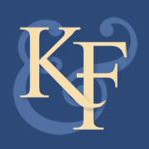 Kolbe & Fanning are pleased to announce that they are expanding their current offices in Gahanna, Ohio (part of the Columbus Metropolitan
Area). We have occupied our current office since George Kolbe and David Fanning joined forces in early 2010, but both the office and a separate
storage facility have slowly filled with stock and consignments. When the business located next door to us moved, we were presented with the
opportunity to expand into it—retaining our original space, but adding about 1,000 square feet of office space. It was too good of an opportunity to
pass up.
Kolbe & Fanning are pleased to announce that they are expanding their current offices in Gahanna, Ohio (part of the Columbus Metropolitan
Area). We have occupied our current office since George Kolbe and David Fanning joined forces in early 2010, but both the office and a separate
storage facility have slowly filled with stock and consignments. When the business located next door to us moved, we were presented with the
opportunity to expand into it—retaining our original space, but adding about 1,000 square feet of office space. It was too good of an opportunity to
pass up.
 And apparently, it was meant to be. When the contractors cut through our drywall to begin the process of running a door through the wall to
connect the two offices, they found that there was already a door in place, sealed up in the existing walls! Even the owner of the building had no
idea it was there.
And apparently, it was meant to be. When the contractors cut through our drywall to begin the process of running a door through the wall to
connect the two offices, they found that there was already a door in place, sealed up in the existing walls! Even the owner of the building had no
idea it was there.
While that sped up the construction process, there remains work to be done, so final photos will have to wait. We are looking forward to having the extra space, however, which will allow us to more effectively and efficiently sort material—as well as increase the number of books for sale on our website (already some 1300+ titles). It will also provide us with a dedicated photography room and additional storage.
Our mailing address will remain the same, so there is no need to update our contact information. We look forward to serving our clients in the coming year.
To view the Kolbe & Fanning web site , see:
www.numislit.com

NEWMAN NUMISMATIC PORTAL SPONSORS SCANNING AT ANS
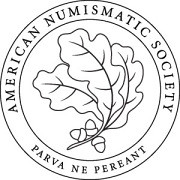
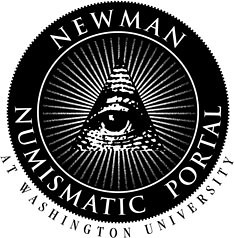
Sponsored by the Newman Numismatic Portal, Internet Archive has launched scanning operations at the American Numismatic Society and is currently working through the American auction catalogs in the ANS Rare Book Room. Equipment arrived at the ANS in early December, and scanned documents are now appearing online in the ANS Collection on the Internet Archive website. As of Friday, December 17, over 50 19th century sales have been posted.
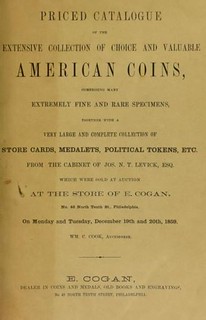 One of the first catalogs scanned was Edward Cogan’s sale of the Levick collection from December 1859 (Adams 5, Davis 252), representing a
typical mix for the day of federal coinage (silver and copper, but no gold), colonials, patterns, Washington pieces, and a selection of American
tokens and medals.
One of the first catalogs scanned was Edward Cogan’s sale of the Levick collection from December 1859 (Adams 5, Davis 252), representing a
typical mix for the day of federal coinage (silver and copper, but no gold), colonials, patterns, Washington pieces, and a selection of American
tokens and medals.
Levick is perhaps best known for the Levick plate of 1793 large cents appearing in the April, 1869 issue of the American Journal of Numismatics, and it is no surprise that the 1793 cents in this sale were among the most highly prized lots. Five are listed, without varieties, with an average price realized of over eight dollars, as compared with early silver dollars or patterns, many of which sold for two or three dollars each. This particular copy is inscribed by Levick to the ANS and was donated in 1866.
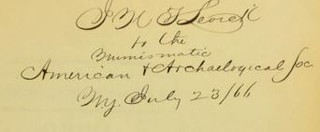
Link to ANS Internet Archive collection: https://archive.org/details/americannumismaticsociety
Link to Levick sale catalog: https://archive.org/details/pricedcatalogueo00coga_8
Link to Newman Portal / ANS partnership announcement: http://www.coinbooks.org/esylum_v18n47a02.html
The American Numismatic Society (ANS) is delighted to announce a joint project with the Newman Numismatic Portal, an online numismatic resource, which will enable greater access to American numismatic research material on both the ANS Digital Library and Newman Portal websites.
“We are thrilled to have this opportunity to begin distributing some of the Library’s research collections on a large scale in the same way that much of the Society’s coin collections are being made available through online research tools like PELLA, OCRE, and MANTIS,” said ANS Librarian David Hill, who will supervise the onsite operations.
“When you think about all of the materials in the Library’s Rare Book Room, which include unique archival collections such as dealer and collector correspondence, you really begin to realize what an impact a project like this can have.”
First to be scanned will be the Library’s entire run of early American auction catalogs, which include those of Frossard, Woodward, Chapman, Elder, and other notable names in the field.
To read the complete article, see:
ANS, Newman Numismatic Portal
Announce Joint Scanning Project (www.coinweek.com/education/ans-newman-numismatic-portal-announce-joint-scanning-project/)
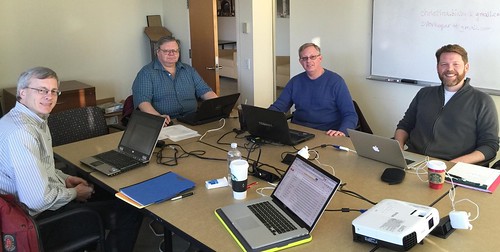
Len Augsburger, Roger Burdette, Wayne Homren and Chris Freeland;
photo by John Feigenbaum
To read the earlier E-Sylum article, see:
WAYNE'S NUMISMATIC DIARY: JANUARY 18, 2015
(www.coinbooks.org/esylum_v18n03a26.html)
ANS PARTICIPATES IN HUMANITIES OPEN BOOK PROJECT
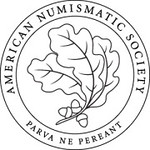 The American Numismatic Society has been chosen as one of ten publishers to participate in the Humanities Open Book project, a joint
NEH-Mellon Foundation grant program to convert out-of-print books of enduring scholarship into EPUB e-books, which will be licensed so as to allow
readers to search and download these books freely, and to read them on any type of e-reader.
The American Numismatic Society has been chosen as one of ten publishers to participate in the Humanities Open Book project, a joint
NEH-Mellon Foundation grant program to convert out-of-print books of enduring scholarship into EPUB e-books, which will be licensed so as to allow
readers to search and download these books freely, and to read them on any type of e-reader.
ANS publications date back to 1866 and include over 500 volumes of numismatic scholarship. Thanks to the funding received from the Mellon Foundation, nearly 100 of its rarest out-of-print books will be converted into free EPUB digital editions. The ANS will go one step further by TEI-encoding these editions for online viewing, searching, and linking. Following best-practices of Linked Open Data (LOD), these XML files will link to (and will be able to be linked from) other Open Access (OA) resources like the Virtual International Authority File, the Pleiades Gazetteer of Ancient Places, and ANS digital projects like OCRE and PELLA.
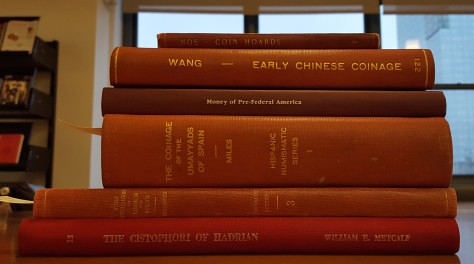
Pictured above are just a few of the some one hundred works that will be processed. The assorted works digitized through this generous Humanities Open Book grant will be available via the ANS Digital Library by the end of 2016.
To read the complete article, see:
NEH-MELLON FOUNDATION HUMANITIES OPEN BOOK
PROJECT (www.anspocketchange.org/neh-mellon-foundation-humanities-open-book-project/)
THE BOOK BAZARRE
NEW BOOK: FRENCH COINAGE SPECIFICALLY FOR COLONIAL AMERICA
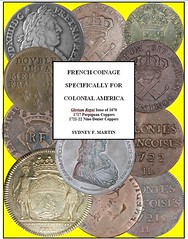 The Colonial Coin Collectors Club, C4, released Sydney F. Martin’s latest book, French Coinage Specifically For Colonial America.
This is the third colonial coin book published by C4 written by Syd Martin. Other works include The Rosa Americana Coinage of William Wood and
The Hibernia Coinage of William Wood. The Rosa and Hibernia books are now considered standard references for those coinages and Syd’s long
awaited new book is expected to become the leading reference works on French Coinage minted for circulation in North America.
The Colonial Coin Collectors Club, C4, released Sydney F. Martin’s latest book, French Coinage Specifically For Colonial America.
This is the third colonial coin book published by C4 written by Syd Martin. Other works include The Rosa Americana Coinage of William Wood and
The Hibernia Coinage of William Wood. The Rosa and Hibernia books are now considered standard references for those coinages and Syd’s long
awaited new book is expected to become the leading reference works on French Coinage minted for circulation in North America.
According to Lou Jordan, the curator of numismatic collections for the University of Notre Dame, “Syd Martin has written the definitive catalog of French coinage authorized specifically for use in North America.” Jordan went on to state that “this is an essential book for anyone interested in the French coinage of colonial North America.”
“What many early American coin collectors fail to recognize,” Martin said upon the book’s release, “is that from the 16th century until 1763, New France included much of what is now the United States, as well as most of Canada. As such, coins minted by France for circulation in its North American colonies should be considered ‘coins of the realm’ in these areas.” Colonial numismatic expert, John Kraljevich, went on to explain that “the history of the French in what is today the United States is largely forgotten. However, the memory of these people and their coinage has been long cherished in Canada”
Jim Rosen, president of C4, predicts that “Martin’s new book will awaken an interest in both the history of the French speaking people in North American and the coins they used such as the Gloriam Regni coins of 1670, the 6 and 12-denier copper coins minted in 1717, and the copper 9-denier coins from 1721 and 22, all of which were struck in France specifically for circulation in the Americas.”
In the book’s introduction, John Kraljevich writes that, “With Crosby-like flair, Syd has marshaled together the original documents that tell the stories of these coinages. Most have never been published at all, let alone in English or all in one place. This original research guarantees this work’s importance to researchers in every forthcoming generation. The heart of this book, the die studies, offers several pathways for collectors to navigate these series, by basic type, by major variety, by die combination, or even by die state. It’s a project that no one has ever even attempted before, an outlier in the world of colonial numismatics, a field that has seen multiple die studies of most of the popular series. Given Syd’s well-organized approach and the thousands of coins he’s studied, it may be generations before this work is supplanted. It’s doubtful anyone will ever do it any better.”
The 480 page book is hardbound, well-illustrated throughout with photographs of the different coin varieties examined, with dust jacket depicting French Coinage. French Coinage Specifically For Colonial America, by Sydney F. Martin, is available for $85.00 plus $7.00 shipping from bookseller Charles Davis, (http://www.numisbook.com/), Box 1, Wenham, MA 01984, or telephone 978.468-2933
Introduction (John Kraljevich)
Preface
Acknowledgements
Abbreviations Used
PROLOGUE
SECTION ONE: THE GLORIAM REGNI ISSUES OF 1670
Chapter 1. Introduction
Chapter 2. Making the Coins
Chapter 3. The 15-Sol Gloriam Regni Issue of 1670
Chapter 4. The 5-Sol 1670-A Gloriam Regni Issue
Chapter 5. The Double of 1670
Appendix A: Rarity Assessments of Gloriam Regni Coins
Appendix B: Gloriam Regni Miscellanea
SECTION TWO: THE COPPER PERPIGNAN ISSUES OF 1717 FOR NEW FRANCE
Chapter 1. The Copper Perpignan Issues of 1717
Chapter 2. 1717-Q 12 Deniers
Chapter 3. 1717-Q 6 Deniers
Appendix A: 1717-Q Coppers – Miscellanea
SECTION THREE: THE NINE DENIERS OF 1721-1722
Chapter 1. Historical Overview
Chapter 2. Description of the Nine Deniers Coins
Chapter 3. Making the Coins
Chapter 4. Presentation of Obverses and Reverses
Appendix A: Miscellanea
Appendix B: Grading
Appendix C: 9-Denier Rarity Estimates
Appendix D: A Correlation of Other 9-Denier Taxonomies
BIBLIOGRAPHY
INDEX
NEW BOOK: COIN OF THE CANONICAL REALM
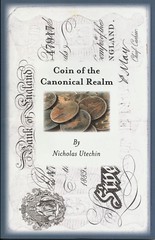 In this, the first monograph published by the John H Watson Society, Nicholas Utechin sets out to make 21st century sense of all the 19th
century mentions of money in the Sherlock Holmes stories.
In this, the first monograph published by the John H Watson Society, Nicholas Utechin sets out to make 21st century sense of all the 19th
century mentions of money in the Sherlock Holmes stories.
Have you ever stopped to wonder exactly what a ‘half-sovereign’ would buy today? Find out what Mary Morstan stood to gain if the Agra treasure had not been hurled out of the Aurora. How much in dollars – then and now – would Neville St. Clair’s daily begging takings have amounted to? Could Sir Henry Baskerville’s $6 boots have been bought for an equivalent sum in 2014?
Coin of the Canonical Realm is an important work whose validity might not survive all-engulfing world inflation, but currently provides the first ever detailed snapshot of the practicalities of Holmes’s financial world.
About the author: NICHOLAS UTECHIN is a Director-at-Large of the John H. Watson Society (‘Rex’), a Baker Street Irregular (‘The Ancient British Barrow’) and an Honorary Member of The Sherlock Holmes Society of London (having edited “The Sherlock Holmes Journal” from 1976-2006). He is a freelance journalist and worked for many years as a producer and presenter on BBC radio. He lives in Oxford, U.K.
Through a partnership agreement with the John H Watson Society, we are able to offer copies of this work in our online shop. Print copies of the monograph can be purchased for $12 and a PDF download can be purchased for $10.
To read the complete article, see:
Book: Coin of the Canonical Realm by
Nicholas Utechin (http://fourthgarrideb.com/2015/12/book-coin-of-the-canonical-realm-by-nicholas-utechin/)
For more information, or to order, see:
MONOGRAPH – Coins of The Canonical Realm
(http://fourthgarrideb.com/product/monograph-coins-of-the-canonical-realm/)
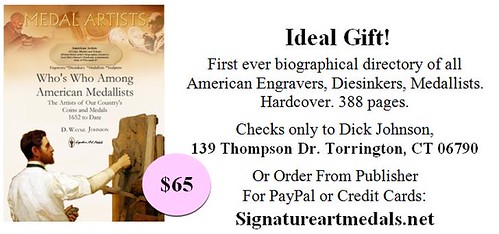
BOOK REVIEW: COIN COLLECTORS SURVIVAL MANUAL, 7TH ED.
 As a coin collector for more than 50 years, I have a very select library. For years, Scott Travers’ The Coin Collector’s Survival
Manual was a must-have work that informed and enhanced my numismatic education. Viewers of Coin Update know about my background in coins,
including serving as a columnist for Coin World and as a former member of the Citizens Coinage Advisory Committee. Many also know that I am a
journalism educator and author of media ethics and technology books, including works by Oxford University Press.
As a coin collector for more than 50 years, I have a very select library. For years, Scott Travers’ The Coin Collector’s Survival
Manual was a must-have work that informed and enhanced my numismatic education. Viewers of Coin Update know about my background in coins,
including serving as a columnist for Coin World and as a former member of the Citizens Coinage Advisory Committee. Many also know that I am a
journalism educator and author of media ethics and technology books, including works by Oxford University Press.
Revising editions of acclaimed books is a distinct skill requiring keen knowledge not only of subject matter–in Travers’ case, numismatics–but also of deletion of outdated material, insertion of at least 50% new material (justifying purchases by owners of the last edition), and expert copy editing to ensure the work reads in a consistent tone of voice.
Unfortunately, these standards are not met in the seventh edition. That said, it is still one of the few must-have books.
What does this mean? If you have the sixth edition, you probably don’t need this one. If you do not own this book, you should buy it.
First, let me tout why this work is essential. It features a cogent history that truly is a survival manual for novice and apprentice collectors. Some of the highlights, also found in other editions, include these chapters:
- The Grading of U.S. Coins, including sections on certification services, manufacturing methods, numerical standards, overgrading and undergrading, and doctored-coin detection.
- Grading Services and the Plastic Revolution, including sections on the impact of such services, grading by consensus and changes in grading standards.
- Don’t Let Uncle Sam Pick Your Pocket, including sections on US Mint products, tax obligations, estate-planning secrets and retirement planning.
Because this was once a numismatic masterpiece, every level of collector and investor can find something to like and inform in each of the 23 chapters with appendices.
However, the savvy reader of Coin Update News, especially a hobbyist with numismatic experience, also may find something outdated or no longer relevant in many of these chapters.
For instance, on page 148 in the section on crossovers at NGC and PCGS, Travers leaves the reader with the impression that NGC will consider grading coins from other holdering companies when, in fact, that policy was changed years ago.
In general, the work assumes coin purchases will be made through dealers or at coin shows. There is an outdated, pessimistic 13-page section about buying coins on the Internet, focusing on eBay rather than on the dozens of reputable venues and portals offering coins via Internet and smartphones, from Proxibid to GreatCollections. This chapter of Travers’ book includes a self-indulged section titled “An Exchange of Correspondence with eBay” that is slanted journalism with leading questions by the author, reprinting of contentious replies and few facts that help any collector “survive” the online coin purchasing business.
I blame Travers’ copy editor, assuming his publisher Random House hasn’t already downsized copy editors.
As viewers of Coin Update News know, increasingly hobbyists not only are buying coins on Internet but also on smartphones. (Proxibid has just rolled out a mobile phone version still in its development stages.) Moreover, there needs to be a new Survival Guide written by someone who actually uses the Internet to purchase coins.
The last Amazon review, posted Nov. 9, 2015 and titled “Please Rewrite This Book,” captures the key points of my own review here of the seventh edition.
I recommend it for numismatic history, grading practices and services, counterfeit detection, fourth-party grading companies such as Certified Acceptance Corporation, and tax and legal advice.
However, if this is the only resource upon which novices depend, they won’t survive if purchasing or bidding on coins online rather than from dealers or at shows. Internet coin buying and selling deserves its own survival manual. That information isn’t in the seventh edition, sloppily edited (if edited at all) by Random House.
To read the complete article, see:
Review of the 7th Edition of
Travers’ Coin Collector’s Survival Manual
(http://news.coinupdate.com/review-of-7th-edition-of-travers-coin-collectors-survival-manual/)
THE BOOK BAZARRE
COURTNEY COFFING (1920-2015)
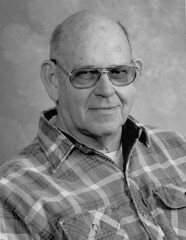 Retired Bank Note Reporter editor and German notgeld authority Courtney L. Coffing died Dec. 13 at the age of 95.
Retired Bank Note Reporter editor and German notgeld authority Courtney L. Coffing died Dec. 13 at the age of 95.
Though his numismatic interests began early, his numismatic career began in middle age.
Mr. Coffing was proud to have joined the American Numismatic Association in 1947, but his first professional numismatic assignment began in 1965 when he joined the staff of the Amos Press weekly Coin World based in Sidney, Ohio.
There his interests in world issues led to his being assigned to World Coins magazine. He also worked on Numismatic Scrapbook.
From 1960 to 1965 he had been a civilian U.S. Army employee in West Germany. He was an education advisor.
While he was there, he helped organize coin clubs in Wiesbaden in 1960 and Kaiserslautern in 1962.
Coffing retired from Coin World in 1983, worked briefly for East Lansing, Mich., coin dealer Joseph L. Lepczyk and joined the numismatic editorial staff at Krause Publications in Iola, Wis., in 1984 where he was made editor of Bank Note Reporter.
He served in that position until 1987.
After his second retirement, he founded his own publication about notgeld called the Fraktur.
In 1988, his book, A Guide & Checklist of World Notgeld, 1914-1947 and Other Local Issue Emergency Money, was published by Krause.
Early on he had served in the Civilian Military Training Corps and the U.S. Border Patrol from which he enlisted in the U.S. Marine Corps.
His World War II Marine service included the battle of Iwo Jima and a post-war assignment in China.
During the Korean War he was a mortar school instructor and retired as a staff sergeant.
His civilian service to the military also included time as an U.S. Air Force instructor.
Mr. Coffing’s funeral was to be held Dec. 22 at the Iola United Methodist Church.
He is survived by a son, a daughter and three grandchildren.
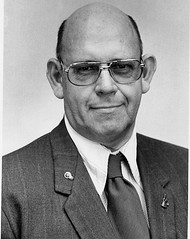 Courtney L. Coffing, 95 passed away in his sleep early morning of Dec. 13, 2015. Courtney now joins his beloved wife Wanda, his parents
William and Millie Coffing and his sister Ruth in Heaven. He is survived by his son Larry (Barbara) of Beach Park IL., adopted daughter Catharine
(Fred) of Iola, WI, grandsons Matthew and Anthony and three great grandsons.
Courtney L. Coffing, 95 passed away in his sleep early morning of Dec. 13, 2015. Courtney now joins his beloved wife Wanda, his parents
William and Millie Coffing and his sister Ruth in Heaven. He is survived by his son Larry (Barbara) of Beach Park IL., adopted daughter Catharine
(Fred) of Iola, WI, grandsons Matthew and Anthony and three great grandsons.
Courtney lived a long rewarding life firmly rooted in his Christian Faith as a life long Methodist serving the church for many years as a Sunday School Teacher and Lay Leader. His life of service began in the Civilian Military Training Corps and the U.S. Border Patrol from which he enlisted in the U.S. Marine Corps.
His WWII service included the battle of Iwo Jima and postwar China. During the Korean War he was a mortar school instructor and retired as a Staff Sergeant. His civilian service to the military included time as an U.S. Air Force Instructor and as a U.S. Army Education Advisor in Europe.
Returning to the U.S., Courtney spent 18 years with Amos Press in Sidney, Ohio writing and editing for the Coin World and World Coins publications followed by a short period of time with coin auctioneer Joe Lepczyk ended by Joe’s tragic death. In 1984 Courtney joined the Krause Publications Numismatic division before retiring and starting his own Notgeld publication, the Fraktur.
Throughout most of his life he was a very active member of the Veterans of Foreign Wars, The Marine Corps League and the Lions Club receiving some of their highest awards. Finally as old age over took them Courtney and Wanda took up residence in the King Veterans Home where the wonderful staff provided the best care possible anywhere.
Visitation Dec.21, 2015, Voie Funeral Home, Iola 3-6pm.
Funeral Dec.22, 2015, Iola United Methodist Church 11 am.
Followed by lunch at the Glacier Woods (Iola) Country Club 12:30 pm.
ANA LAUNCHES NEW EDUCATIONAL VIDEO SERIES
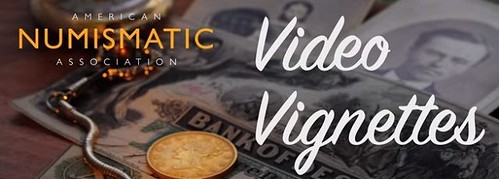
The American Numismatic Association has launched a new video series called “Video Vignettes,” featuring ANA Education Director Rod Gillis. The clips range from 3 to 5 minutes in length and cover topics aimed at helping collectors become more judicious and informed.
Three videos have already been uploaded to the ANA’s Web site; they are included below along with brief descriptions provided by the American Numismatic Association.
COIN COLLECTING 101
This brief introduction for the beginner stresses the importance of deciding how to collect so that you can collect intelligently and
derive the maximum amount of thrill from the hobby. Specific coin types are mentioned to help you focus on your collecting interests.
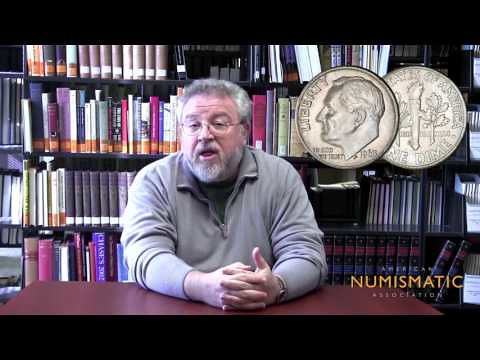
UNDERSTANDING GRADING
Many people shy away from grading. This discussion explains the two major different approaches to grading, and highlights resources that
will aid you in expanding your grading knowledge.
WHAT GIVES COINS VALUE?
In this brief discussion, learn the three most important variables that determine how much a coin is worth. Hint: One variable that has
very little to do with value may be the first one that comes to mind.
Coin Collecting 101 offers solid advice to a beginner, and as a bibliophile I enjoyed the backdrop of bookshelves, providing a subtle reminder that there's a lot to be learned in this hobby. While the editing was good (superimposing images of the coins being discussed), I would recommend placing even more visual emphasis on the coins themselves - switch from a talking head to a voiceover mode for significant stretches of the video. Show the coins full screen in all their numismatic and artistic glory instead of a small inset above the narrator's shoulder.
The earlier ANA Money Talks series of short audio programs tailored for radio would be ideal for repurposing for video. Great scripts and narration already exist, and historical images and photos of numismatic items could be added independently by a video editor working with a researcher who would locate appropriate images. -Editor
To read the complete article, see:
ANA Launches New Video Series with Rod Gillis
(http://news.coinupdate.com/ana-launches-new-video-series-with-rod-gillis/)
To view the videos from the ANA web site, see:
VIDEO VIGNETTES (www.money.org/video-vignettes)
COINWEEK UPGRADES VIDEO, INTRODUCES PODCAST
In 2016, CoinWeek will realize its longterm goal of becoming a fully multi-media numismatic publication. We have invested tens of thousands of dollars in new state-of-the-art video and audio equipment and will be uploading all of our videos online in 4K Ultra High Definition on our YouTube channel. You don't have to have the latest monitor or TV to see the improvement either. The difference in the clarity and quality of our videos going forward will be obvious.
"CoinWeek also has launched the CoinWeek podcast. Two times each week, CoinWeek will publish audio versions of our most interesting articles, interviews, and educational segments onto the iTunes store, where you can download them for free - or stream them online.
"We thank the numismatic community for giving us the opportunity to cover the industry and the hobby and we look forward to seeing all of you in person in 2016."
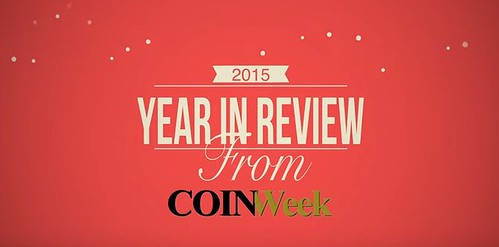
To view the complete video, see:
CoinWeek: 2015 Year in Review 4K Video - The Year's Top Coin Stories
(www.youtube.com/watch?v=0aVCc1KygYA)

MISSING MANCHESTER MUSEUM COIN REGISTER SOUGHT
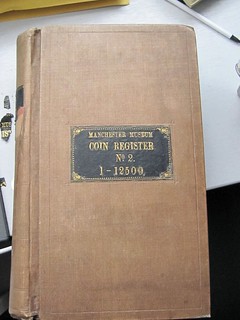 Please may I make an appeal about a missing accession register from our Numismatic collection at Manchester Museum? I am trying to trace
the first volume of the accession register for the William Sharp Ogden coin catalogue. This has been missing from our Numismatics department at
Manchester Museum for many years (since before the 1970s) and I wish to make an appeal to readers of the newsletter in the hope that someone might
have seen it in a collection somewhere. It may look something like the second volume that we still have in the collection. As it had 2,950 coin
record entries, it represents a very important piece of documentation for our coin collection, and it would be wonderful to find out what happened to
it.
Please may I make an appeal about a missing accession register from our Numismatic collection at Manchester Museum? I am trying to trace
the first volume of the accession register for the William Sharp Ogden coin catalogue. This has been missing from our Numismatics department at
Manchester Museum for many years (since before the 1970s) and I wish to make an appeal to readers of the newsletter in the hope that someone might
have seen it in a collection somewhere. It may look something like the second volume that we still have in the collection. As it had 2,950 coin
record entries, it represents a very important piece of documentation for our coin collection, and it would be wonderful to find out what happened to
it.
William Sharp Ogden (1844-1926) was a Manchester architect who seems to have designed few buildings that have survived to the present day [for a list see Girouard (Town and Country New Haven; London: Yale University Press, 1992, p.99) who dismisses his published design work rather sniffily]. Sharp Ogden served on the Manchester Museum Committee and collected coins and stone artefacts and other archaeological material. His important art collection was presented to the Whitworth Art Gallery. He died in London in 1926.
Please contact Brian Sitch with any information at Bryan.Sitch@manchester.ac.uk
MORE ON DIGITAL NUMISMATIC LITERATURE
Ray Williams writes:
It was nice to read about the C4 Newsletter being available on the Newman Numismatic Portal. I'm thrilled The Numismatist is available to ANA members online! So much information is available at our fingertips in seconds. Crosby & Maris had to do it the old-fashioned way... the mail and telegraph and personal travel. What we can learn immediately took them weeks or months, making theirs (and others') accomplishments all the more impressive!
James Higby writes:
I share Les Citrome's disappointment in the inability to download complete back issues of The Numismatist. One morning a few days before the December 1 "grand opening" I visited the ANA website and was able to download all the issues intact from June 2014 to the present. During that process I noticed that all issues from, I believe, 2009 on were also available, but I had to leave the computer for a couple of hours. When I came back, expecting to complete my set back to 2009, everything was gone except what I had been able to download. Now we have to settle for downloading one or two pages at a time. It is not what I had hoped for and expected, especially in these days of being able to have complete sets of things such as the C4 Newsletter, Penny-Wise, and Colonial Newsletter available to read almost as if having the periodical in hand. The current arrangement requires us to have a topic or keyword in mind, whereas having an entire issue or series of entire issues at hand allows for those Eureka! moments of serendipitous learning.
James Higby adds:
I have the complete back files in hard copy of American Heritage, Fine Woodworking, and the Civil War Token Journal. I love to pull them down from their shelves, sling back in the recliner, and travel to the past. But those collections occupy about twenty lineal feet of shelving, and I can't imagine what 127 years of The Numismatist or Numismatic Scrapbook might require. Lucky you if you have them and the space to house them, but most of us do not. A complete, digital copy is the next best thing, but as you observed, it requires a lot of squinting.
To read the earlier E-Sylum articles, see:
NEWMAN NUMISMATIC PORTAL DIGITIZES C4 NEWSLETTER
(www.coinbooks.org/esylum_v18n50a03.html)
MORE ON THE NUMISMATIST DIGITAL ARCHIVE : Wanted: Others Ways to Access
Numismatist Issues (www.coinbooks.org/esylum_v18n50a17.html)
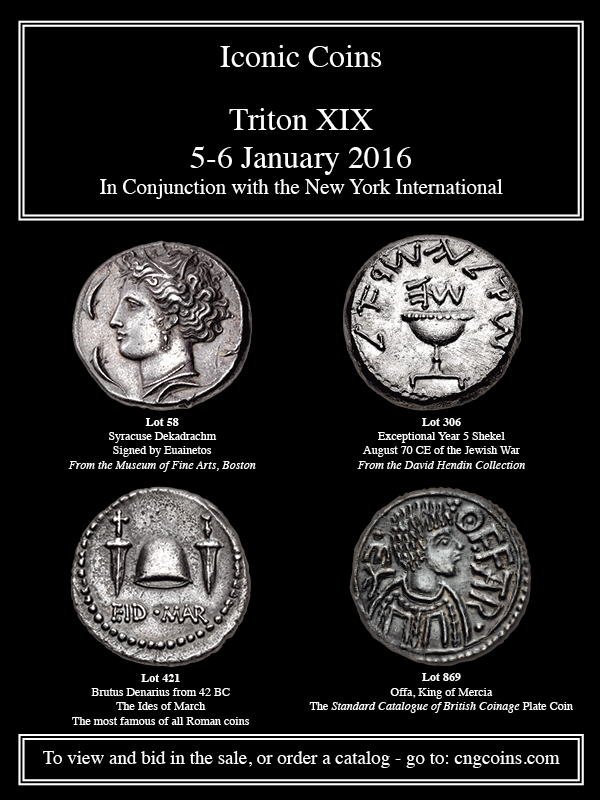
NOTES FROM E-SYLUM READERS: DECEMBER 20, 2015
The U.S. Mint Refuses Greenbacks
Dave Hirt writes:
The post on Greenbacks, Gold, and American Capitalism reminded me of a problem A M Smith encountered during the period mentioned. Reading the March, 1880 issue of Smith's Coin and Collectors Illustrated Guide. Smith tells of going to the mint in Philadelphia in late 1879, to purchase 1879 Proof Sets, which had just gone on sale. He tried to make payment in Greenbacks, which the mint refused.
Smith was miffed! He said, "Our beloved president as said, Greenbacks are as good as gold." He was forced to pay with hard money. It seems like some things never change. I remember when I subscribed to current numismatic publications, almost every week there would be letters to the editor complaining about dealings with the mint.
To read the earlier E-Sylum article, see:
GREENBACKS, GOLD AND AMERICAN CAPITALISM
(www.coinbooks.org/esylum_v18n49a21.html)
On the Great Seal Star Constellation

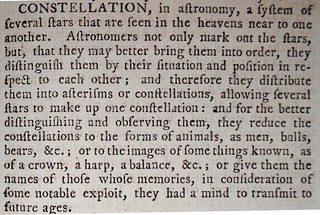
Some people have interpreted the intent of the Great Seal star constellation as a random grouping of stars, usually in reference to Charles Thomson's proposed drawing of the Great Seal, which was considerably modified in the final version. The eighteenth-century definition of a constellation describes "a system of several stars" which I have imaged from my set of Dobson's Encylopædia. With this definition, the final arrangement of the stars on the original Great Seal die is correct, and not in error as some have described it.
Robert Scot used six-pointed stars in his designs, which have two opposing points in a linear axis, allowing Scot to easily align them into a pattern. I have included an image of a Commissioner of Revenue counterstamp engraved by Robert Scot, similar to one pictured in my book Robert Scot: Engraving Liberty. This is exactly the same hexagram pattern that is on the original Great Seal die, with individual six-pointed stars rotated in a vertical orientation, and arranged into a single six-pointed united star that "denotes a new State," which is quite an ingenious design of the thirteen stars.
Both Thomson and Scot had reputations as being honest and trustworthy, and there little chance of them putting hidden meanings into something as important as the Great Seal. In my book I described that most of the Great Seal symbols had been previously used for various religious and cultural purposes, and they "suggest a borrowed symbolism, with a synthesis of all design elements adapted for a new interpretation of an exclusively American meaning for the Great Seal." Although there is no evidence of Haym Salomon being involved with the Great Seal, I did describe his financing activities during the revolution as being "strategically crucial to the American cause."
To read the earlier E-Sylum article, see:
HAYM SALOMON MEDALS (www.coinbooks.org/esylum_v18n50a22.html)
HOWARD DANIEL ON MEETING DR. ALBERT PICK
Back in the late 1970s, I was in the early stages of my numismatic life and very few people knew me. I had just published the second edition of my France (French Southeast Asia Coins & Currency) catalog in 1978. My wife and I were in Heidelberg, Germany, at the time because I was still in the U.S. Army and stationed there.
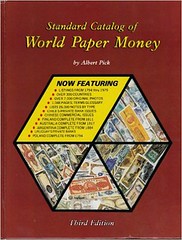 We decided to make a visit to Munich and made reservations at the U.S. military hotel in the city. I had heard about Dr. Pick and the new
Krause Publications' Standard Catalog of World Paper Money by him so I decided to take a chance and send a letter asking to meet him. He
quickly answered my letter and told me he would be happy to meet me and that he would show me Southeast Asia paper money of interest to me. I
confirmed the date and time, and we drove down to Munich.
We decided to make a visit to Munich and made reservations at the U.S. military hotel in the city. I had heard about Dr. Pick and the new
Krause Publications' Standard Catalog of World Paper Money by him so I decided to take a chance and send a letter asking to meet him. He
quickly answered my letter and told me he would be happy to meet me and that he would show me Southeast Asia paper money of interest to me. I
confirmed the date and time, and we drove down to Munich.
I called him from the hotel and a taxi ride later, we were in the bank and being escorted to his office. Dr. Pick's wife was also there and took Phung away on a walking/shopping trip near the bank so she would not be bored with our talking and looking at paper money. Fantastic! We had a couple of hours together and he treated me like an equal. I will never forget his kindness and absolute willingness to share his knowledge with me. And then his wife escorting my wife around Munich too! It was a wonderful visit for both of us.
One of these days, I hope to meet him, and other good guys and gals in numismatics, again on the "other side."
To read the earlier E-Sylum articles, see:
WORLD PAPER MONEY AUTHOR ALBERT PICK PASSES AT 93
(www.coinbooks.org/esylum_v18n48a10.html)
ALBERT PICK (1922-2015) (www.coinbooks.org/esylum_v18n50a12.html)
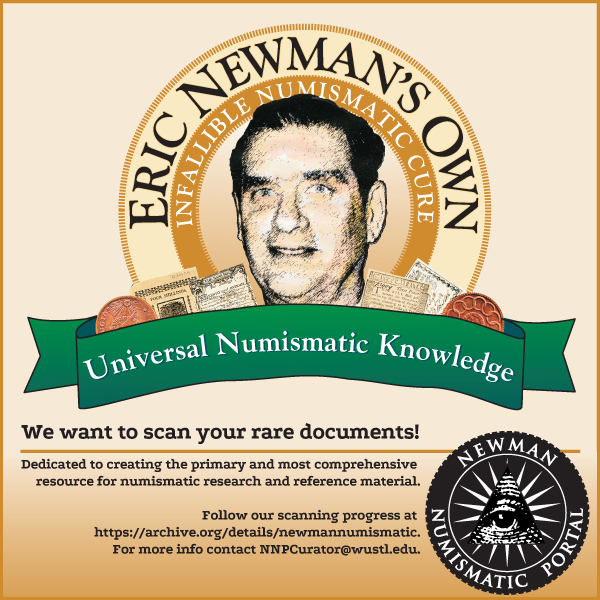
HERSHEL THOMAS DANIEL (1905-1973)
Hershel Thomas Daniel (1905-1973), was born May 15, 1905, son of James L. Daniel, and Chlora Daniel, at Pittsburg, Johnson County, Arkansas. He married Rachel Stilley on October 3, 1924. They had a son Daniel Barton Daniel (1928-), and a daughter Barbara (1935-).
He was an amateur archaeologist who, like the coin dealer, Robert Wood Mercer of Ohio, became prominent among Indian relic dealers but also dealt in coins, medals, paper money, wampum, curios, minerals, fossils, etc., trading out of Dardanelle, Arkansas. G. E. Pilquist, another Indian relic dealer from Arkansas proceeded him dealing as early as 1907. Daniel was one of the last of the classic curio cabinet dealers who traded in natural and artificial curiosities as well as coins. "American numismatics antiseptically isolated from curiosities as a specialized field of collecting started to trend during the 1940's, something colonial British North American numismatists would hardly be able to understand or appreciate since the notion was inconceivable to them."
 H. T. Daniel began dealing in the 1920's and continued at different cities in Arkansas into the 1960's. He advertised regularly in
Hobbies Magazine. He operated a store under various names and in 1940 after moving from Dardanelle it was called like Mercer's Ohio shop,
the Curio Store, located at Hot Springs, Arkansas.
H. T. Daniel began dealing in the 1920's and continued at different cities in Arkansas into the 1960's. He advertised regularly in
Hobbies Magazine. He operated a store under various names and in 1940 after moving from Dardanelle it was called like Mercer's Ohio shop,
the Curio Store, located at Hot Springs, Arkansas.
Many of the top American coin dealers dealt with Indian relics, especially Henry Chapman magnate of the coin dealing dynasty from 1875-1934. Perhaps one of the main contributing factors after the death of Henry Chapman during the 1940's that removed coins and coin dealing from the classic curiosity cabinet items, especially Indian artifacts was the fact that fakes began to circulate more frequently than the authentic bona fide item.
Although fake or counterfeit coins had always been in circulation among coin dealers since the 18th century the majority of coins sold in the market were and are authentic. This was not the case with other artifacts of the curiosity cabinet, especially the notorious fake Indian relics. "Daniel began dealing in “fake” artifacts “when collectors began expecting artifacts more exotic and rare than existed prehistorically”
Being a regular advertiser in Hobbies Magazine he took umbrage with editorials published in that magazine that criticized many of the Indian artifacts circulating among the dealers as fakes. "In a letter to the editor in the December 1935 edition, Daniel wrote thatHobbies' sky-is-falling attitude toward fakes only scared people off from buying authentic artifacts from reputable dealers.
Daniel's letter was the height of hypocrisy because Daniel himself was the source of many forgeries.
He died at the age of 68 years, 4 months, and 11 days, on September 4, 1973 at Lamar, Arkansas.
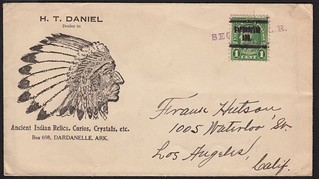
Business envelope of Hershel T. Daniel postmarked with Scott No. 552 (1922-1925) Precancel "Farmington, Arkansas" c. 1925. Courtesy the Lupia Numismatic Library. It is curious that he used a precanceled postage stamp from Farmington in Washington County 120 miles northwest of Dardanelle, along Lake Dardanelle, Yell County.
To read the complete article, see:
DANIEL,
HERSHEL THOMAS (https://sites.google.com/site/numismaticmallcom/encyclopedic-dictionary-of-numismatic-biographies/daniel-hershel-t)
On a related note Dave Hirt writes:
Regarding the item on R. W. Mercer, I own several of his publications: his one auction sale of May, 5, 1879 (I have a priced copy) , and his Numismatic Directory (I have an 1884 edition).
The posted notice of him listing dealers who were selling fake American Indian material was quite interesting to me, because some time later W. E. Woodward said the same thing about Mercer, warning collectors against buying Indian material from a man in Cincinnati.
To read the earlier E-Sylum article, see:
ROBERT WOOD MERCER (1840-1894) (www.coinbooks.org/esylum_v18n49a18.html)

MEDAL ON FRENCH AND SPANISH FLEETS DEFEAT OFF TOULON
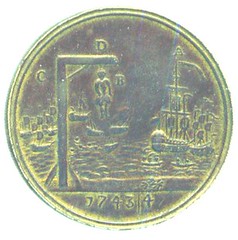
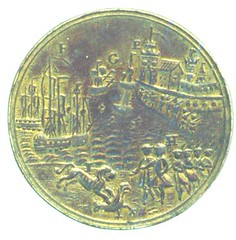
Dick wrote:
The medal is about 39mm, maybe the thickness of a quarter. Looks like gilt bronze with most of the gold gone. Either that or that is luster showing through. I get the impression that there was a written description accompanying the medal because of the A, B, C etc. that are in the design

HANOVER. 1727-1760. Brass Medal (38mm, 13.87 g, 5h). French and Spanish Fleets Defeated off Toulon. Dated 1743|4. Harbor scene with aspects denoted by the following letters —
A: in background, ships under sail on sea to right;
B: in foreground, human body suspended from gallows (D) to left;
C: in background, smaller ships under sail on sea to left; 1743|4 in exergue / Harbor scene with aspects denoted by the following letters —
E: in background, fortified town under attack to right;
F and G: in background, ships under sail right attacking town;
H: in foreground, troops advancing left to right;
I: in foreground, lion pouncing right on cock.
MI 584/224; Eimer 582.
To read the complete lot description, see:
www.cngcoins.com/Coin.aspx?CoinID=183460
A pamphlet was probably issued with this medal to identify the aspects that are marked alphabetically. The medal commemorates the Battle of Toulon 1744, which was a part of the War of the Austrian Succession (1740-48). Sides were initially drawn due to the claim that Maria Theresa was ineligible to succeed the Habsburg throne. Great Britain and the Dutch Republic sided with Austria against Prussia and France who saw the dispute as an opportunity to challenge the power and influence of the Habsburg throne. Spain joined the war against Britain and Austria to reassert control over colonies and trade routes that had weakened during the early 18th century due to the expense of their own war of succession.
To read the complete description, see:
www.bryantcoins.com/styled-101/styled-345/index.html
To read the earlier E-Sylum article, see:
UNDERDOCUMENTED MEDAL ASSISTANCE SOUGHT
(www.coinbooks.org/esylum_v18n50a25.html)
NUMISMATICS OF THE DOW-DUPONT CHEMICAL COMPANIES
Donald Tritt writes:
Described here is a Du Pont numismatic item pertinent to your upcoming article. This is a well-executed piece in excellent condition. I know of only one other copy of this. However, I expect several of these likely exist.
1933
Du Pont “No Accident” Campaign Die-pressed wooden medal 37mm (3mm thick)
Obverse
Facing right, bust of E. I. Du Pont
Above: “The Founder of E. I. Du Pont de Nemours & Co.”
Below: “E. I. Du Pont de Nemours”
Around outer circle: “Purpose / Knowledge / Forethought / Concentration”
Reverse
Centered above, “Du Pont” in the iconic Du Pont ellipse, then below:
“Fifth Annual / No Accident / Month / Campaign / June 1933.”
Signed: “Martin D. Myers, Philadelphia.”
Paul Cunningham writes:
I had the Dow medal recently and it wasn't very popular! It seemed to be aluminum but, as an afterthought, why not magnesium alloy (instead of aluminum? Dow has been famous for years for producing magnesium material.
Those few who took a second look at the medal weren't impressed. I recall it might have sold for $150. It was very "fat" in the center, perhaps something in the 1 to 1 1/2cm thickness. Very high relief.
Dow has been in the news in Michigan lately because the business was initially thinking about moving some production overseas.
To read the earlier E-Sylum article, see:
NUMISMATICS OF THE DOW-DUPONT CHEMICAL COMPANIES
(www.coinbooks.org/esylum_v18n50a26.html)
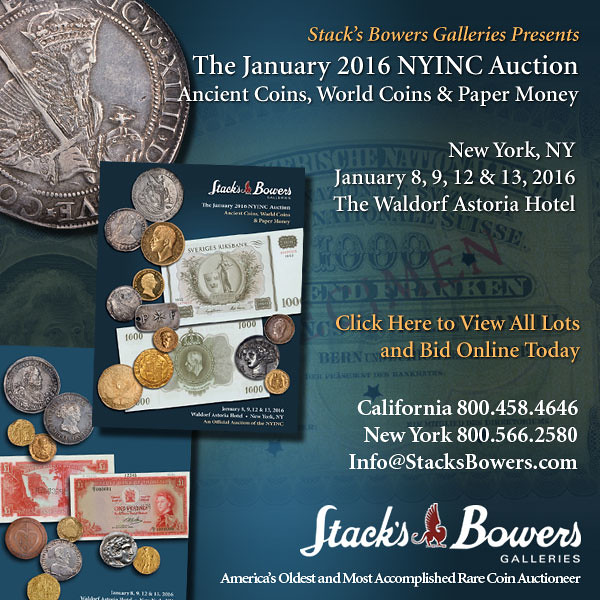
COUNTERSTAMP COMMEMORATES ALBERT EINSTEIN
Albert Einstein was a citizen of three countries—his birthplace Germany, Switzerland and the United States. Germany and Switzerland have issued coins to commemorate him, as have countries whose connections with Einstein have ranged from close (Israel) to tenuous (China, France, Paraguay, San Marino, and Thailand). While the United States issued stamps in honor of Einstein in 1966 and again in 1979, his adopted country has never issued a coin in honor of the scientist who was named “Person of the Century” by Time Magazine.
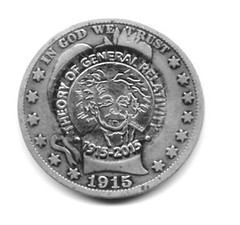 Mel Wacks, Director of the Jewish-American Hall of Fame hopes that the United States will someday issue a commemorative coin to honor
Albert Einstein, but in the interim he has created counterstamped U.S. coins to celebrate the 100th anniversary of Einstein’s Theory of General
Relativity.
Mel Wacks, Director of the Jewish-American Hall of Fame hopes that the United States will someday issue a commemorative coin to honor
Albert Einstein, but in the interim he has created counterstamped U.S. coins to celebrate the 100th anniversary of Einstein’s Theory of General
Relativity.
Wacks states that “Nothing like this has ever been done before. I discovered and purchased a hoard of one hundred 1915 Barber Half Dollars in undamaged circulated condition, and in turn these have been counterstamped on the obverse with the likeness of Einstein and an appropriate inscription.”
Einstein published his Theory of General Relativity in 1915. In it, he determined that massive objects cause a distortion in space-time, which is felt as gravity. Imagine setting a large body in the center of a trampoline. The body would press down into the fabric, causing it to dimple. A marble rolled around the edge would spiral inward toward the body, pulled in much the same way that the gravity of a planet pulls at rocks in space.
The accompanying Certificate of Authenticity indicates that no more than 100 of these commemoratives will ever be made. They are available from the non-profit Jewish-American Hall of Fame, 5189 Jeffdale Ave., Woodland Hills, CA 91364 (order with credit card by calling 818-225-1348) for $65 plus $5 shipping, but if you mention that you read about it in E-Sylum you can take a 30% discount. Each coin comes with a free bonus—a trial strike on a new brass planchet of the counterstamp design commemorating the 100th anniversary of Einstein’s Theory of General Relativity (no more than 100 minted).
Wacks notes that “because these 100-year old coins have different degrees of wear and toning, each counterstamped coin will be slightly different—and unique.”
Thoughts on Coin Mutilation
Mel Wacks writes:
I appreciate your comments. But I feel that I raised worn common dates worth not much more than melt to interesting counterstamped commemoratives.
COUNTERFEITING IN BOSTON, 1806-1808
The freewheeling commercial world that was budding in Boston during the early nineteenth century has been ably captured by Jane Kamensky’s The Exchange Artist (2008). Kamensky focuses on the story of Andrew Dexter, Jr., a speculator whose rise and fall served as a cautionary tale for the newfound banking and paper money industry.
The book is well worth a read, but the short version is that Dexter financed his schemes by gaining a controlling interest in a particular bank and then issuing more bank notes than the institution could ever possibly redeem. The most infamous of these was the Farmers’ Exchange Bank of Glouscester, Rhode Island, which issued an incredible number of notes beginning in the spring of 1808. Dexter quite literally used the bank to print money in order to finance an extravagant real estate project known as the Exchange Coffee House.

$10 bill issued by the Farmers’ Exchange Bank in April 180
The scheme eventually collapsed when the public realized that the bank was unable to meet its extensive obligations, but knowledgable exchange brokers likely reaped a profit by divesting themselves of the specious notes in advance.
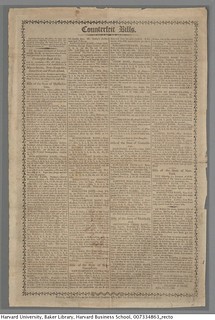 The public thus needed to be wary not only of counterfeiters, but of bankers as well. Uncertainty allowed exchange offices and information
brokers like Gilbert & Dean a variety of ways to profit from their particular knowledge. In February 1806, the firm published a broadside (12″
x 18″) that promised “to meet the public anxiety respecting Counterfeit Bills” by listing known fakes in circulation and providing details
about all of the regional banks that issued notes. The Baker Library at Harvard University has the only copy of this seminal counterfeit detector
that we know of.
The public thus needed to be wary not only of counterfeiters, but of bankers as well. Uncertainty allowed exchange offices and information
brokers like Gilbert & Dean a variety of ways to profit from their particular knowledge. In February 1806, the firm published a broadside (12″
x 18″) that promised “to meet the public anxiety respecting Counterfeit Bills” by listing known fakes in circulation and providing details
about all of the regional banks that issued notes. The Baker Library at Harvard University has the only copy of this seminal counterfeit detector
that we know of.
A typical description listed problems with the paper (too dark, too thin, etc.) or details like poorly set type and missing or altered elements for the public to ferret out fake bills. Gilbert & Dean were notably not doing this as a public service but to reap a profit, as the broadside cost 12 and a half cents (a bit or eighth of a dollar). Nearly fifty examples of counterfeit bills are noted, giving a good impression as to the scope of the problem.
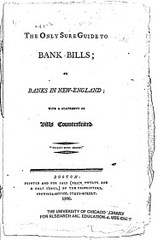 The broadside was such a success that the firm published a follow up during the summer of 1806. The Special Collections Research Center at
the University of Chicago holds a copy of this rare pamphlet entitled The Only Sure Guide to Bank Bills; Or, Banks in Now-England: With a Statement
of Bills Counterfeited. Promising “utility with profit,” it also warned:
The broadside was such a success that the firm published a follow up during the summer of 1806. The Special Collections Research Center at
the University of Chicago holds a copy of this rare pamphlet entitled The Only Sure Guide to Bank Bills; Or, Banks in Now-England: With a Statement
of Bills Counterfeited. Promising “utility with profit,” it also warned:
If any one should suffer for want of information, rather than buy a pamphlet, the blame must attach to himself alone; and he will not receive that commisseration which in justice he ought.
The twelve-page pamphlet provides details on forty-six banks while noting that there were seventy-four banks in operation in the whole United States, the balance of which were located in New England.

$1 note for Union Bank of Boston counterfeited by Burroughs in 1807
To read the complete article, see:
GILBERT & DEAN AND COUNTERFEITING IN
BOSTON, 1806-1808 (www.anspocketchange.org/gilbert-dean-and-counterfeiting-in-boston-ca-1806-1808/)
To read the earlier E-Sylum articles, see:
BOOK REVIEW: THE EXCHANGE ARTIST BY JANE KAMENSKY
(www.coinbooks.org/esylum_v11n15a06.html)
NEW BOOK: THE EXCHANGE ARTIST: AMERICA'S FIRST BANKING COLLAPSE
(www.coinbooks.org/esylum_v11n35a04.html)
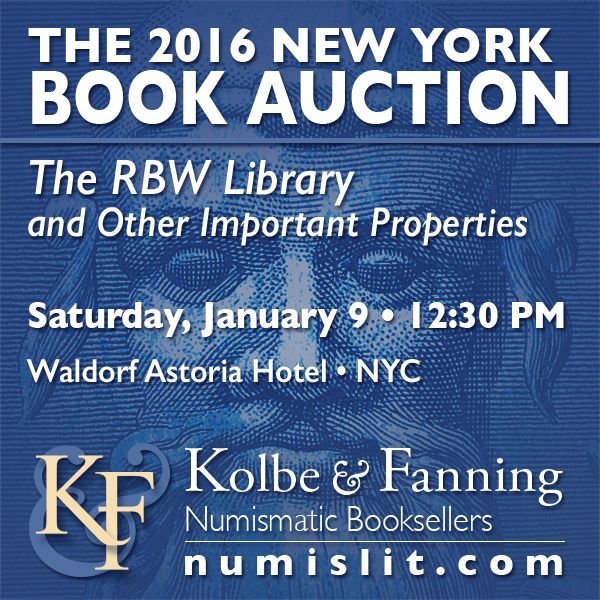
ARTICLE PROFILES FANCY SERIAL NUMBER COLLECTORS
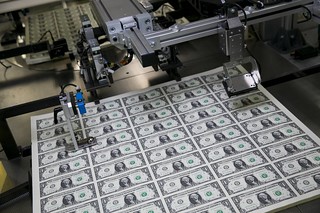 When is a dollar worth more than a dollar? The answer is when it is a “fancy” note like a repeater, a ladder or maybe even a flipper.
When is a dollar worth more than a dollar? The answer is when it is a “fancy” note like a repeater, a ladder or maybe even a flipper.
For a niche of currency collectors, the value of paper currency goes beyond that assigned by the full faith and credit of the U.S. government. These hobbyists appreciate—and often put a premium on—the string of digits in the serial numbers that every bill of every denomination has.
Low serial numbers—think 00000001—are a favorite among the group and have some of the loftiest values, sometimes in the thousands if the condition is top-notch. But fans of fancy notes also look for all sorts of other configurations and curiosities that go by a variety of names. There are radars, like 12344321, where the digits read the same both ways as with a palindrome; repeaters such as 20152015, in which the numbers repeat in some fashion; solids like 77777777, which speaks for itself; and ladders like 12345678 where the digits ascend, or descend as the case may be, in order.
These notaphilists—as currency collectors are broadly known—have largely remained on the fringe, buying and selling among themselves via fan forums on the Web and scoping their wallets for finds. But the hobby has had something of a star turn over the past year, with attention from the likes of late-night TV host Stephen Colbert stirring up interest from treasure-seekers looking to cash in on their cash.
“I had no idea you could get rich collecting money,” Mr. Colbert quipped during a spoof segment on fancy serial numbers in early November.
While Mr. Colbert was using the hobby as a punchline, it is simply a fun pastime for most collectors that does, for some, provide a modest sideline to finance their pursuit of notes.
“I thought the Colbert bit was funny, even though it’s always a little painful to have people mock your hobby,” says Dave Undis, a longtime fancy-serial enthusiast who has written about the hobby and runs CoolSerialNumbers.com, a website dedicated to fancy bank notes.
“People see stuff like that and they start looking in their wallets and start thinking they’re going to get rich,” says the 61-year-old Mr. Undis, a retired insurance executive in Nashville, Tenn. “If you go in as an investment, it’s probably a mistake.”
To be sure, some notes can command significant premiums. Low serial numbers often carry the best values for their popularity. One example: A seller on eBay recently was asking $114.99 for a professionally graded $1 bill with the serial number 00000046.
But most fancy bills trade only slightly above face value. And many of the most sought-after by collectors really have only sentimental or personal value, like their child’s birthday or an anniversary (04072004, say, for April 7, 2004); ZIP Codes (00090210, where the final five digits in this instance represent the postal designation for Beverly Hills, Calif.); tombstones (19182014, here representing the birth and death years of a long life as they might appear on a gravestone; and others known by such names as Fibonaccis after the mathematical sequence and flippers whose digits look the same right-side up or upside down.
This collecting niche hasn’t gone unnoticed by the government. The Bureau of Engraving and Printing sets aside some choice notes—none with serial numbers below 100, however—from its print runs for sale to collectors. One series sold by the bureau included “one $10 note from each of the 12 Federal Reserve Banks” with the lowest serial numbers available.” The set went for $359.40.
The bureau also pitches its Lucky Money collection. One example is the bureau’s $1 Fortune Notes, where “each uncirculated note has a serial number beginning with ‘8888’ enclosed in an attractive folder festively adorned with Chinese art and symbolism.“ It aims to capitalize on the 8 being seen as a lucky number in Chinese culture. A single $1 bill in this series goes for $5.95, plus shipping and handling, though customers who buy in bulk can get volume discounts of up to $2 per note for 1,000 or more.
As the hobby has picked up attention in mainstream and niche media over the past year, the number of treasure-hunters with dollar signs in their eyes has grown.
While Mr. Futrell says he hasn’t seen an increase in sales from this attention, he has seen a boom in requests for the value of bills. “What I have been is bombarded with questions asking about notes’ values,” he says, such as: “Is my note with 66632214 worth anything?”
To read the complete article, see:
These Collectors Hunt for
Dollars With ‘Fancy’ Serial Numbers (www.wsj.com/articles/these-collectors-hunt-for-dollars-with-fancy-serial-numbers-1450147126)
1896 EDUCATIONAL SERIES: A FLAWED EXPERIMENT

They were the most beautiful federal notes ever issued, vastly more artistic than anything in circulation in the United States today. And they were abject failures, replaced by new designs within two years in response to complaints from bank tellers and the public. They were the Series 1896 silver certificates — the Educational Series of $1, $2, and $5 notes. In a contest between artistry and practicality, art lost.
What happened? Why were notes whose beauty is so prized today replaced so quickly? Blame the mural-style artwork, the “newness” factor, their susceptibility to counterfeiting, unhappy bank tellers, and saleswomen who objected to the “indelicate figures” on the notes. As the New York Times reported in 1897, they were “doomed.”
The effort was noble. Treasury and Bureau of Engraving and Printing officials wanted to raise note design to new heights, much like officials sought to improve U.S. coinage design, starting a decade later. But a number of problems conspired to end the experiment sooner than expected.
By 1893, Treasury Department and Bureau of Engraving and Printing officials had begun talking to artists about the next generation of silver certificate. Sometime before Nov. 1, 1893, researcher Gene Hessler writes, the Treasury Department had selected three muralists to create designs for the new notes. All three men — Will H. Low, E.H. Blashfield and Walter Shirlaw — were established artists, with Low and Blashfield being Paris-trained as painters and Shirlaw also being a bank note engraver. According to Hessler in his U.S. Essay, Proof and Specimen Notes, each was commissioned at $800 per design selected.
The designs for the faces of the new notes would depart from the portrait style used on the existing silver certificates they were replacing. Officials gave the muralists a broad canvas with which to work, deciding, for the notes’ faces, to let each design encompass nearly the entire side of the note. A decision was also made to let the notes adhere as closely as possible to the designers’ original paintings. To do that, the BEP chose not to use lathework on the faces of the notes. According to Hessler, the 1896 silver certificates are the only federal notes issued since 1861 to lack this form of printing. That would become a problem.
The notes debuted to mixed reviews. While an Aug. 15, 1897, New York Times article acknowledged that the artistry of the notes was well above previous issue, Hessler writes, the innovative approach at design was causing problems on multiple fronts.
Heavy use of black ink on the faces made the notes overly dark and easily smudged. The smudging made them “suspicious with a little use” according to the article. Bank tellers had difficulty telling them apart, as “the number denominations [were] too indistinct for rapid use at the banks,” reported The Washington Times in a May 1, 1897, article. In a comment duplicated a century later after a massive redesign of Federal Reserve notes, the Aug. 15 article in the New York paper noted, “The first objection to them was that they were new.” Also, the notes were targets for counterfeiters, with the lack of complicated lathework on the faces making the job easier for forgers.
Despite efforts to lighten the darkness of the faces and fix other problems, the criticisms of the three notes were so great that the government canceled work on the $10 and larger denominations and quickly began working on a replacement series. The Treasury secretary promised, “When the next change is made it will be to return to the old style notes — not necessarily to the old designs,” according to Hessler. The Treasury secretary added that “the designs will be so distinctive there will be no difficulty in confusing them.” The replacement Series 1899 notes, while attractive, are not in the same class as the 1896 notes, but they were successful, with the $1 and $5 notes not replaced until 1923. The grand experiment had ended in failure.
To read the complete article, see:
Beautiful
failures: An 1896 flawed experiment in paper money design
(www.coinworld.com/news/paper-money/2015/12/Series-1896-silver-certificates-were-beautiful-failures.all.html)

THE 1796 PAUL I NOVODEL RUBLE
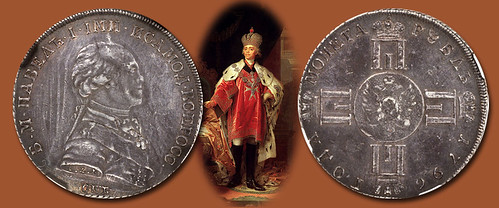
Today’s highlight coin is an incredible rarity from the reign of Russian emperor Paul I, a visually appealing Novodel Ruble designed by Carl Leberecht (with his initials on the truncation). Paul I was the son of Empress Catherine II the Great though he never earned her favor or blessing to succeed her. Catherine intended her grandson (who would later become Emperor Alexander I) to succeed her as she distrusted her son politically. However she was unable to formally announce this before she died of a stroke. Paul was aware of this sentiment as most of his life he stayed at his various estates and away from her court. In response to his near miss of succession to the throne, one of the major changes he enacted after becoming emperor was a revamping of the laws of succession, changing it from a system where the ruling Emperor or Empress could choose their successor to a strict primogeniture system.
This type is referred to as the “Portrait Ruble” in contemporary documents. The coin features a portrait of Emperor Paul I wearing a uniform of the Preobrazhensky Guards Regiment with a diagonal sash of the Order of Saint Andrew and Cross of Saint Anne at the throat. With subsequent production coinage lacking a portrait, this piece represents one of the few examples extant displaying the Czar, and in what is considered to be a very well executed portrait that was approved by Paul I himself. The reverse displays Paul’s monogram in cruciform around the heraldic Imperial double headed eagle within a circle. Dark intense tone uniformly covers the surface, with limited silver color showing through along the highest points. Seldom offered and always of the greatest interest.
Look for this and other world numismatic rarities in our upcoming January New York International Auction.
To read the complete article, see:
Very
Rare Russia 1796 Paul I Novodel Ruble (www.stacksbowers.com/NewsMedia/Blogs/TabId/780/ArtMID/
2678/ArticleID/65497/Very-Rare-Russia-1796-Paul-I-Novodel-Ruble.aspx)
CHINESE GOVERNMENT CUTS SILVER IN PANDA COINS
Drage Vukcevich writes:
The Chinese Government is lowering the amount of silver in their silver Panda coins, from 31.1 grams (1 troy ounce) to only 30 grams. The claim is that this is being done for Asian collectors, who look more at gram weights than troy weights.
I say, B*LLSH*T! Just another stinking Communist LIE. All they want to do is cheat people out of silver.
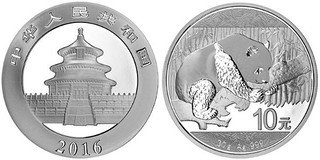 Today, the usage of the troy ounce unit of weight is down to almost only measuring the mass (weight) of precious metals. In the past it had
been used as part of the apothecary system and was the base of the British Imperial troy ounce from about 1400 through 1971.
Today, the usage of the troy ounce unit of weight is down to almost only measuring the mass (weight) of precious metals. In the past it had
been used as part of the apothecary system and was the base of the British Imperial troy ounce from about 1400 through 1971.
The usage of troy ounce weights traces its history back to the ancient Roman monetary system. At one point in Roman history, bronze bars were used as currency. The aes grave (meaning heavy bronze) weighed one pound. The unit called uncia, which became ounce in the English language, was defined as one-twelfth the weight of the aes grave.
The troy ounce weighs 31.1034768 grams (usually rounded to 31.1 grams) or 480 grains or 20 pennyweights. In contrast, the avoirdupois ounce used to weigh bananas and humans weighs 28.349523125 grams (usually rounded to 28.35 grams), 437.5 grains, or 18.229 pennyweights. A troy ounce is about 10 percent heavier than the avoirdupois version. To be precise, the troy ounce is 192/175 times the weight of the other ounce.
In the London Bullion Market and on commodity exchanges in the United States, precious metals contracts are specified in a certain number of troy ounces. On the New York COMEX, for instance, a gold contract is for 100 troy ounces, a silver contract is 5,000 troy ounces, platinum is 50 troy ounces, and palladium is 100 troy ounces.
Two events, one that just happened and one coming in April 2016, may end up with the use of troy ounce measurements in precious metals becoming obsolete.
With the recent release of the 2016-dated Chinese Pandas, the sizes are no longer stated in troy ounce measurements. Instead, the coins that used to weigh one troy ounce now weigh 30 grams, slightly less than prior year issues. Smaller-sized coins are also proportionately smaller. To help minimize confusion, the new coins list their precious metal content in grams.
This change was announced about a year ago. In the Far East, metric measurements are the standard, so the new coins make them more practical for trading in that part of the world.
The Shanghai Gold Exchange is planning to begin trading 1 kilogram (1,000 grams or about 32.15 troy ounces) gold contracts in April 2016. Once again, the weight standard matches what is commonly used in the Far East.
There are two features to these forthcoming SGE contracts that have a good chance of shifting the world’s dominant precious metals markets from the West and also away from the U.S. dollar. First, the SGE contracts will be fulfilled by immediate delivery of the physical metal instead of merely being the exchange of paper assets. Almost certainly, some percentage of the world’s gold investors would prefer 100 percent certainty of owning gold versus merely holding a piece of paper. Second, the SGE contracts will be priced in Chinese yuan and payment can only be made using that currency.
If you think that the close timing of these two events that push for metric weights of precious metals instead of the troy ounce measurements means they are related, it is not out of the question. The Chinese government has been aggressively signing bilateral agreements with governments across the globe to displace the use of U.S. dollars in international transactions and payments, using instead the currencies of the signatory nations. If not deliberately timed to coincide with each other, the modification of Panda weights and the forthcoming trading of Shanghai Gold Exchange contracts both using metric standards is consistent with other actions of the Chinese government.
Since the world’s largest gold consuming nations, China and India, use metric weights for governmental and private precious metals trading, it is highly likely that people in many other Far East nations will also adopt metric units and the Chinese yuan as benchmarks for measuring precious metals transactions.
Considering this information, I would not be at all surprised to see the usage of troy ounce weights for precious metals disappear within the next decade or two.
To read the complete article, see:
Do grams or ounces win?
(www.numismaticnews.net/article/do-grams-or-ounces-win)
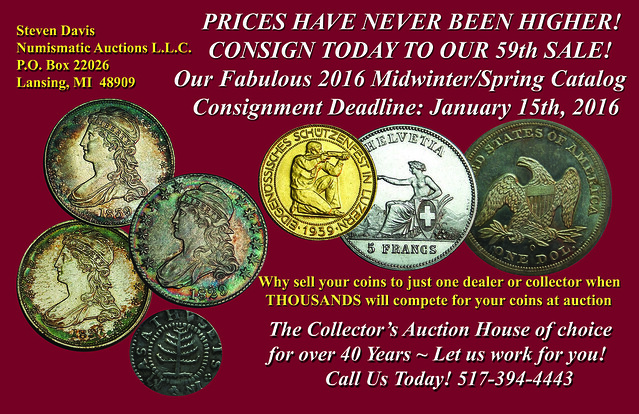
SOHO MINT DIES OFFERED IN WOOLLEY & WALLIS SALE
Lot 446: Die for Matthew Boulton's Trafalgar Medal
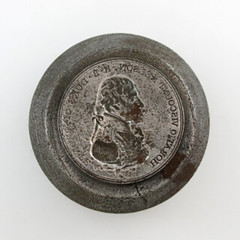 Admiral Lord Nelson (1758-1805), Matthew Boulton's Trafalgar Medal, 1805, the original obverse and reverse dies, by Conrad Heinrich
Küchler, obv: uniformed bust of Nelson, HORATIO VISCOUNT NELSON K.B. DUKE OF BRONTE. &c, rev: view of the naval engagement, ENGLAND EXPECTS THAT
EVERY MAN WILL DO HIS DUTY, exergue: TRAFALGAR. OCT. 21. 1805; the reverse die with deep alignment cut on edge, 55 x 68mm, 57 x 71mm (BHM.584;
Milford Haven 1919, 496; Eimer 960; Pollard, NC 1970, 30). Good fine, actual medal surface showing rust damage. (2) T
Admiral Lord Nelson (1758-1805), Matthew Boulton's Trafalgar Medal, 1805, the original obverse and reverse dies, by Conrad Heinrich
Küchler, obv: uniformed bust of Nelson, HORATIO VISCOUNT NELSON K.B. DUKE OF BRONTE. &c, rev: view of the naval engagement, ENGLAND EXPECTS THAT
EVERY MAN WILL DO HIS DUTY, exergue: TRAFALGAR. OCT. 21. 1805; the reverse die with deep alignment cut on edge, 55 x 68mm, 57 x 71mm (BHM.584;
Milford Haven 1919, 496; Eimer 960; Pollard, NC 1970, 30). Good fine, actual medal surface showing rust damage. (2) T
here were three attempts to obtain a life-like portrait of Nelson, the Nelson family and Lady Hamilton both rejected the first, taken from a drawing by Lady Beechey. Lady Hamilton then provided a miniature and Boulton's friend J. Furnell Tuffin provided a drawing by Simon de Koster, but again this was rejected. Lady Hamilton then provided a wax portrait by Catherine Andras (1775-1860), which she believed to be "the most striking likeness". The reverse battle-scene was designed by the marine artist Richard Clevely, who took it "at the time the Royal Sovereign is going into action partly enveloped in smoke …". The medal was finally completed in October 1806 and the King was presented with a specimen at breakfast on the 24th.
To read the complete lot description, see:
Silver, Vertu, Coins & Medals - Lot 446
(www.woolleyandwallis.co.uk/Lot/?sale=SV190116&lot=446)
Lot 447: 10th Anniversary of Bolton's Death Medal
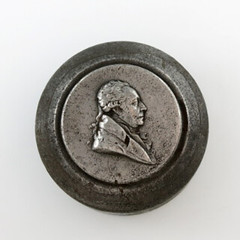 Matthew Boulton, 10th Anniversary of his Death, 1819, the master puncheon die for the obverse of the Memorial Medal, by G F Pidgeon, in the
style of Küchler and after Peter Rouw, bust right, in frock coat, his hair en queue, in positive, without legend, but signed PIDGEON F below bust, 56
x 80mm (cf BHM 976; Eimer 1114; Pollard pp 316-318). Good fine, actual medal surface showing some rust damage.
Matthew Boulton, 10th Anniversary of his Death, 1819, the master puncheon die for the obverse of the Memorial Medal, by G F Pidgeon, in the
style of Küchler and after Peter Rouw, bust right, in frock coat, his hair en queue, in positive, without legend, but signed PIDGEON F below bust, 56
x 80mm (cf BHM 976; Eimer 1114; Pollard pp 316-318). Good fine, actual medal surface showing some rust damage.
Work on the Memorial Medal commenced early in 1812 and as Rouw's wax of 1803 had been broken, he had to prepare a new one for Pidgeon to work from. It was finished in 1815, and the reverse was commenced in November of that year. The obverse squeeze illustrated by Pollard, pl XXIII, 3, differs from the present bust in having no tie to the queue. Pollard quotes Matthew Robinson Boulton writing that it had been completed, "after innumerable obstacles & disappointments…. And finally by the death of the engraver in the progress of the work ….".
To read the complete lot description, see:
Silver, Vertu, Coins & Medals - Lot 447
(www.woolleyandwallis.co.uk/Lot/?sale=SV190116&lot=447)
THE 1930 ADMIRAL RICHARD BYRD PLAQUETTE
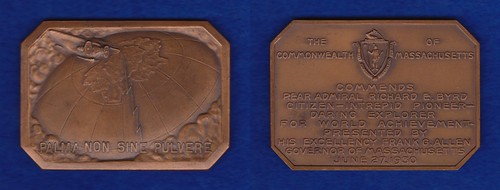
The Commendation plaquette to Admiral Richard E. Byrd from the Commonwealth of Mass. was presented to Byrd by Governor Frank G. Allen on June 27th, 1930. The presentation took place outdoors in the afternoon in the Parkman Bandstand on Boston Common. A noisy crowd of 50,000 or more were there. It was all part of a giant celebration to welcome Admiral Byrd back home to Boston. See the story in the Boston Globe - "Amazing Scenes in Explorers’ Fete" - June 28, 1930 pp1 & 6.
The plaquette is described and the one given to the Admiral was 10K gold. I especially liked Gov. Allen's translation of the Latin inscription: Palma Non Sine Pulvere, "Exploring is no cinch." On the same day another gold plaquette was presented to Byrd by Mayor James M. Curley on behalf of the City of Boston. The Mayor's plaquette was made by the Robbins Co. of Attleboro, MA and I suspect the Governor's plaquette came from the Robbins Co. too. As already noted it mimics the 1927 Lindbergh plaquette which was definitely done by the Robbins Co and was sculpted by John Gregory. For a good account of the Lindbergh plaquette see the New York Times story of June 17, 1927 entitled "Lindbergh Warns Of 'Wildcat' Plans".
The great majority of Byrd's medals, plaques, plaquettes and other awards were sold at auction at Sotheby's in London on November 10th 1988. The Mass. gold plaquette was lot 431 and was estimated at 3,000 to 5,000 pounds. It was illustrated in color in the auction catalog but did not sell. Its whereabouts today are unknown to me.
To read the earlier E-Sylum article, see:
ADMIRAL RICHARD BYRD MEDAL INFORMATION SOUGHT
(www.coinbooks.org/esylum_v18n50a23.html)
THE BOOK BAZARRE
THE JOHNSON PRESIDENTIAL SCHOLAR MEDAL
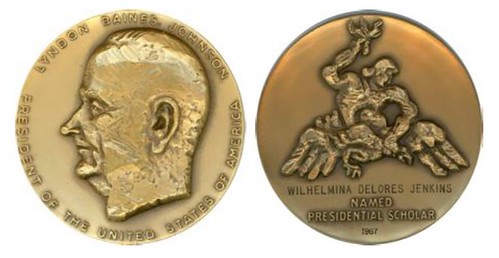
NAMED LYNDON B. JOHNSON PRESIDENTIAL SCHOLAR MEDAL, 1967. Rochette J-64-5. 76.5mm. Bronze. Jacques Lipchitz, Sc. (MACO) Choice Uncirculated in original leather presentation case. Obverse: Naked bust of LBJ facing left surrounded by the legend: LYNDON BAINES JOHNSON PRESIDENT OF THE UNITED STATES OF AMERICA. The reverse portrays the Greek god Prometheus chained to a mountain and being pecked by a vulture. Below: incused name of WILHELMINA DELORES JENKINS/ NAMED/ PRESIDENTIAL SCHOLAR/ 1967. (The reverse is pictured on page 85 of Friedenberg's Jewish Minters and Medalists.)
The U.S. Presidential Scholars Program is a recognition program. Students chosen as U.S. Presidential Scholars receive an expense-paid trip to Washington, D. C. in June and the U.S. Presidential Scholars medallion at a ceremony sponsored by the White House, in commemoration of their achievements. During their visit to Washington, Scholars have access to important national and international figures, including government officials, educators, authors, musicians, scientists and other accomplished people. Scholars are provided opportunities to: wrestle with issues that concern America and the world; attend recitals, receptions and ceremonies held in their honor; and visit area museums and monuments. But perhaps the greatest benefit to the Scholars, and the one they most often remark on, is the chance to exchange ideas with similarly motivated and accomplished peers, and to forge friendships that last a lifetime.
The program was conceived in the Kennedy administration and brought to fruition in 1964 under President Johnson. The initial choice of putting Johnson's profile on the obverse was probably not made by LBJ, as he generally disliked his likeness in portraits. Lipchitz' portrait was no exception as the President was quoted as saying, "Looks like I've been dead three weeks, and maybe ought to be." In spite of this, LBJ did approve the medal and it was presented to all Presidential scholars through the end of his administration when it was changed for Richard Nixon.
Wilhelmina Jenkins was one of the first African-Americans to be recognized as a Presidential Scholar. Now in her sixties, she has lived with chronic fatigue syndrome most of her adult life. A widely regarded spokesperson and face of CFS, she has shared her personal story before national organizations, research and nonprofit groups, and Congressional and public policy briefings about her experience living with CFS. She appeared on a segment of the Oprah Winfrey show about diseases that doctors miss or misdiagnose the most in 1983.
This is the first Johnson Presidential Scholar medal we have ever offered. Previous to this, we have sold single examples of the Nixon, Carter and Ford medals, each of which had different designs. The appearance of a Presidential Scholar in the marketplace is a rarity because they are universally held by the family as prized possessions. The Johnson medal is the only Presidential Scholar design depicting a presidential portrait. It is among the rarest and most desirable of all of his Presidential portraits. $375.00
CARDBOARD TOKEN OF THE PANHANDLE, ANCHORAGE, ALASKA
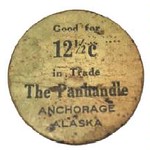 With a photo from 1915 showing Anchorage as a tent city, and The Panhandle among the tents, it is definitely in the running to be
Anchorage’s oldest bar.
With a photo from 1915 showing Anchorage as a tent city, and The Panhandle among the tents, it is definitely in the running to be
Anchorage’s oldest bar.
A photo from 1916 shows The Panhandle on 4th Avenue in what appears to be a frame building. It was on the north side of 4th Ave. It moved to its current location on the south side in the early 1940s and was in a log building. It was rebuilt after a fire in 1949, pretty much as it is today except the east half was Annie’s Cafe until 1990 when the wall was removed and the bar widened. It is currently located at 312 W. 4th Ave.
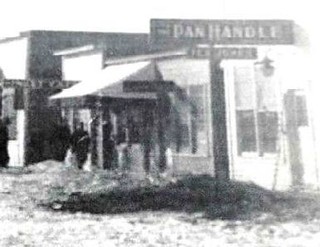
“Notorious Bars of Alaska” claims that during prohibition there was a tunnel connecting the bar with another bar, The Union Club, four doors down at 338 W. 4th., currently occupied by The Avenue. Tony and Jerry don’t believe this, but there are several patches in the basement that could have been a tunnel entrance. These could have been used by earlier bars occupying these locations as both the Union Club and The Panhandle arrived on the scene about 1941, well after prohibition.
There is also a street entrance to the basement, which housed the Silver Slipper. This was also an entrance to an illegal bar during prohibition. The Silver Slipper came into existence about 1950 to 1958 and was for invited customers only, who did not want to rub elbows with the rougher crowd upstairs. The emblem of the Silver Slipper can still be seen on the floor.
Jerry Buffington, who is 73 years old, told me the story of when he was a patron at the Reef Bar at 326 W. 4th Ave. in 1971 and got into a “fight with the Reef’s bartender.” It was closing and the bartender was angry at someone’s cheapness, so he threw a handful of drink tokens at them on the sidewalk. They would throw them back and the fight continued. Jerry still chuckles as he related how the street people were coming in for days and drinking with the tokens.
The token that started this research is shown on the front page. It is a recent discovery, and the only one known. It is made of cardboard, 38mm and printed black on tan (because of age, this may not be the original color of the token). Cardboard is a very fragile material (as compared to metal), and survivorship of this type of token is low.
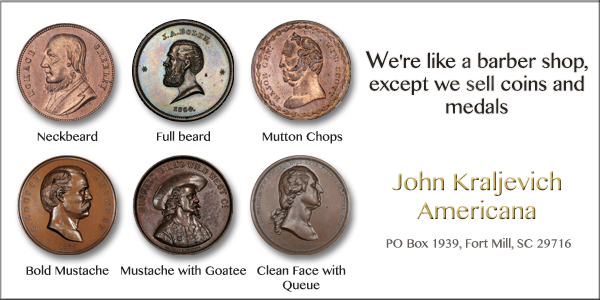
NEW SOUTH WALES' FIRST OFFICIAL BANKNOTE
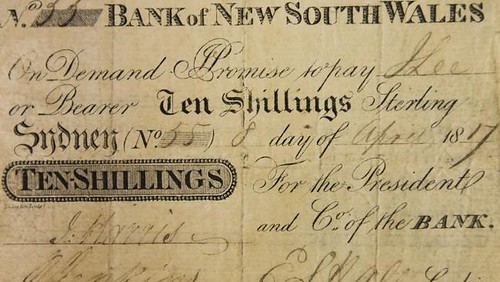
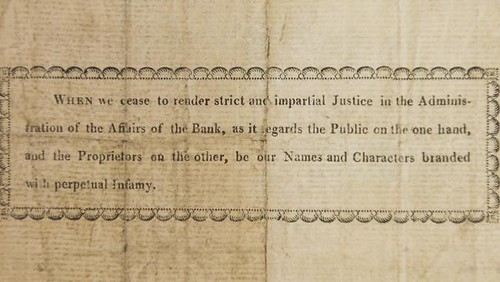
While many countries like to put a pithy motto on their currency, when the colony of NSW printed its first banknotes in 1817 it featured an assurance from the Bank of New South Wales.
“When we cease to render strict and impartial Justice in the Administration of the Affairs of the Bank, as it regards the Public on the one hand, and the Proprietors on the other, be our Names and Characters branded with perpetual Infamy.”
The bank wanted to assure customers it intended to be fair and equitable as the financial underpinning of a growing colony.
That bank later became financial giant Westpac, the same institution that has just loaned the last known banknote from that time to the Australian Museum. Westpac is also sponsoring the transformation of the museum’s Long Gallery into a showcase for 200 of its most significant treasures, of which the note will be a highlight.
The two-centuries-old 10 shilling note was purchased by Westpac last year when it came up for auction after being discovered in Scotland. Its history goes back to the early decades when NSW was a penal colony.
When the British set up their colony in 1788 it was mainly to absorb excess convicts and as a base to look after trading and naval interests in the Pacific and Asia. There were no thoughts of setting up a mint or giving the colony its own currency.
Apart from IOUs privately exchanged, there was also a system of issuing promissory notes to colonists who deposited surplus produce in the government commissariat stores.
These notes promised payment for the produce, but it was only redeemable back in England and was not guaranteed by the government.
A barter system evolved with exchanges of goods and services and at one point alcohol became the most desirable currency, leading to the garrison officers the NSW Corps being nicknamed “the Rum Corps”.
To read the complete article, see:
There’s
nothing ‘rum’ about NSW’s first official banknote
(www.dailytelegraph.com.au/news/theres-nothing-rum-about-nsws-first-official-banknote/story-fnpoi7cy-1227649143855)

THAILAND WINS BANKNOTE DESIGN AWARD
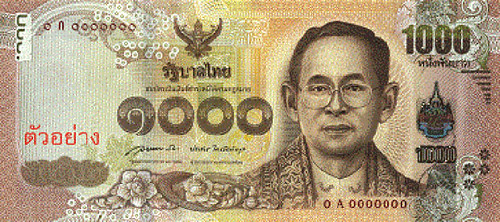
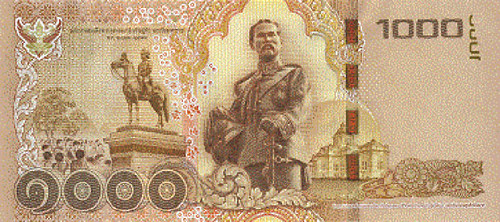
Thailand’s new 1,000-baht banknote has been jointly awarded "Regional Banknote of the Year 2015” along with a new series of New Zealand banknotes at an international conference held by the high security printing industry.
Woraporn Tangsaghasaksri, an assistant to the Bank of Thailand governor, said the 1,000-baht banknote issued as part of the country’s Series 16 notes won the award at the High Security Printing Asia 2015 conference in Jakarta, Indonesia, on Tuesday.
The banknotes, put into circulation in September 2015, have the latest security features to facilitate authentication by machine as well as the general public. They also have tactile features for the visually impaired.
The principal design theme of the new series celebrates Thai kings from different periods.
New Zealand shared the same award for its "Brighter Money" series of new polymer banknotes, the first redesign of the country's currency notes since 1999.
To read the complete article, see:
B1,000 banknote shares regional award
(www.bangkokpost.com/news/general/791913/b1000-banknote-shares-regional-award)
THE HAMILTON TYPE MUSEUM
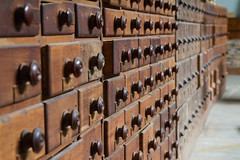 THE HAMILTON WOOD Type & Printing Museum is not of our time. The space itself—a former steel factory in Two Rivers, Wisconsin, that
overlooks Lake Michigan—evokes an era when industrial manufacturing reigned supreme. But it’s what’s inside the museum that transports you to a time
of pounding machines, toxic inks and shellac, sawdust and wood chips, with workers bent over cases of typefaces.
THE HAMILTON WOOD Type & Printing Museum is not of our time. The space itself—a former steel factory in Two Rivers, Wisconsin, that
overlooks Lake Michigan—evokes an era when industrial manufacturing reigned supreme. But it’s what’s inside the museum that transports you to a time
of pounding machines, toxic inks and shellac, sawdust and wood chips, with workers bent over cases of typefaces.
The museum covers 80,000 square feet and houses 1.5 million pieces of type, 6,000 wooden printing plates, and 300 vintage wood type fonts, but it is as much about today as yesterday. The Hamilton is a working museum, where first-time visitors and longtime patrons alike can get their hands dirty. Ten of the museum’s 62 printing presses work, and visitors can learn entry level typesetting or basic letterpress printing. The artists in residence proof and sort incoming type collections and catalog hand-carved blocks, some of them centuries old. It is, in short, heaven on Earth for today’s artisanal printers, typographers, and graphic designers, most of whom were weaned on clean and quiet digital tools.
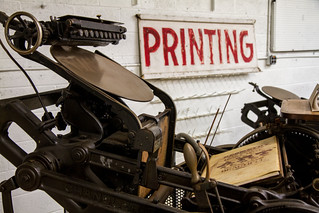 The Hamilton isn’t the world’s only hands-on printing museum. In Europe, Italy’s Tipoteca Italiana, Germany’s Gutenberg Museum, and
Belgium’s Plantin Moretus Museum offer a direct link to the larger history of European culture and politics. Here in the states, the International
Printing Museum near Los Angeles, the Andover Museum of Printing in not far from Boston, the Printing Museum of Houston, and other smaller venues
curate tantalizing collections of printed matter and equipment.
The Hamilton isn’t the world’s only hands-on printing museum. In Europe, Italy’s Tipoteca Italiana, Germany’s Gutenberg Museum, and
Belgium’s Plantin Moretus Museum offer a direct link to the larger history of European culture and politics. Here in the states, the International
Printing Museum near Los Angeles, the Andover Museum of Printing in not far from Boston, the Printing Museum of Houston, and other smaller venues
curate tantalizing collections of printed matter and equipment.
The Hamilton is, however, the world’s largest repository of vintage wood type and the country’s biggest typographical museum. It opened in 1999 with the mission of conserving and commemorating the work of the J.E. Hamilton Holly Wood Type Co. The factory, founded by J. Edward Hamilton in 1880, was at one time the largest manufacturer of wood type in the US. It has since become a popular destination for font fanatics. The museum, which holds fast to its conservationist roots, is the heart a growing movement devoted to preserving the practice of hand-hewn typography.
The annual Wayzgoose conference is among the Hamilton’s most popular gatherings. The affair’s unusual name refers to an annual outing, once organized by master printers for their workers, that marked the end of summer and the start of the season during which work was performed by candlelight. Today, says Bill Moran, the Hamilton’s Wayzgoose conferences are for people “who want to geek out on all things wood type.” It’s an exuberant mash-up of typeface and graphic designers, printers and history buffs. Since 2009, it has attracted hundreds of true believers every year, from the U.S. and beyond, to share new techniques and discoveries.
Bridging the digital and analog gap “has gone a long way,” says Bill Moran, “to building awareness and sharing the museum’s treasure trove.”
To read the complete article, see:
Inside the Hamilton Type
Museum, Where You’re the Printer (www.wired.com/2015/12/inside-the-hamilton-type-museum-where-youre-the-printer/?mbid=nl_121515)
OAK ISLAND ' ROMAN SWORD' FIND
C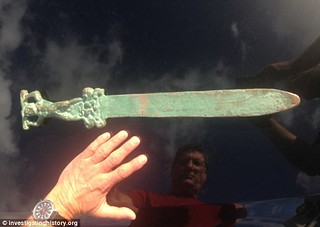 hristopher Columbus landed in what is now the Bahamas in 1492. But was he the first non-indigenous person to reach the Americas?
hristopher Columbus landed in what is now the Bahamas in 1492. But was he the first non-indigenous person to reach the Americas?
Over the years several radical theories have emerged that the Vikings, the Polynesians and the Chinese, arrived before Columbus.
Now, a new group of researchers has come up with another controversial theory; they say the Romans set foot in the New World more than a thousand years earlier.
Researchers, led by Jovan Hutton Pulitzer, claim they have evidence that Roman ships visited North America 'during the first century or earlier.' Their theory centres on the discovery of what they believe to be a Roman sword on Oak Island, off Nova Scotia.
Mainstream historians usually dismiss these finds as inaccurate, claiming artefacts such as this can be dropped by collectors in modern times, according to The Boston Standard.
Scientists are currently unable to rule this out as a possibility, shedding doubt on these claims.
To read the complete article, see:
Did the ROMANS discover America? Radical theory claims sword found on Oak Island suggests ancient mariners set foot on the New World before
Columbus
(www.dailymail.co.uk/sciencetech/article-3364818/Did-ROMANS-discover-America-Sword-Oak-Island-suggests-ancient-mariners-set-foot-New-World-Columbus-according-radical-theory.html)
To read the Boston Standard article, see:
Startling
new report on Oak Island could ‘rewrite history’ of the Americas
(www.bostonstandard.co.uk/news/local/startling-new-report-on-oak-island-could-rewrite-history-of-the-americas-1-7118097)
NO SIGNS FOUND OF PURPORTED NAZI GOLD TRAIN
The Nazi gold train saga took a new twist today when scientists digging the tunnel where it is said to be buried revealed it doesn't exist.
The gold train has been at the centre of feverish speculation since two treasure hunters said they had found it buried nine metres down in a railway tunnel in Walbrzych, south west Poland.
Legend had it, the train was packed with £250million worth of gold and gems was hidden by the retreating German army in the dying days of WWII.
Treasure hunters Piotr Koper and Andreas Richter sparked gold fever when they told the world they had used a ground penetrating radar to locate the train.
But today Professor Janusz Madej from AGH University of Science and Technology, searching at the site, poured cold water on the speculation - and said his team had found no proof of the train's existence.
'The tunnel may be there, but the train is not,' Professor Madej told a press conference.
'The results of our research can be considered reliable,' he added. It brings to an end a saga that has piqued interest of treasure hunters the world over since Mr Koper and Mr Richter announced their discovery in August.
To read the complete article, see:
Was
the Nazi gold train hunt just an elaborate hoax? Scientists dig for buried treasure and find... NOTHING
(www.dailymail.co.uk/news/article-3360931/Was-Nazi-gold-train-hunt-just-elaborate-hoax-Scientists-dig-buried-treasure-NOTHING.html)
The latest report of discovery came in August of this year, when two treasure hunters said they’d determined the location of the train by using a map drawn by a man on his deathbed. But their claim doesn’t seem to have panned out. On Tuesday, experts from Krakow’s AGH University of Science and Technology said that a month of magnetic and gravitational surveys has revealed no trace of an underground rail system or the treasure train that supposedly rode along it. Project leader Janusz Madej said the scientists found some anomalies, but they were just eight feet below the surface — not deep enough to be anything matching descriptions of the train’s hiding spot. “There may be a tunnel,” Madej said at a news conference, “but there is no train.”
To read the complete article, see:
Ballyhooed ‘Nazi gold train’ hidden in mountain doesn’t exist, experts say
(www.washingtonpost.com/news/morning-mix/wp/2015/12/16/experts-say-there-is-no-nazi-gold-train-hidden-in-the-polish-mountains-treasure-hunters-arent-yet-convinced/)
To read the earlier E-Sylum articles, see:
HAS LEGENDARY NAZI GHOST TRAIN BEEN FOUND?
(www.coinbooks.org/esylum_v18n34a26.html)
RADAR USED IN NAZI GHOST TRAIN HUNT
(www.coinbooks.org/esylum_v18n35a35.html)
THE BOOK BAZARRE
COIN OPERATED GAS METER
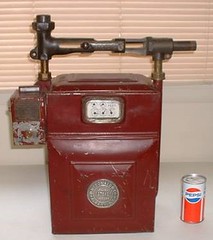
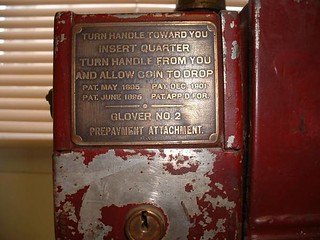
This Very Rare, COIN OPERATED, GAS METER is over 100 YEARS OLD, and was primarily used in Apartment Buildings. Tenants could simply "Pre-Pay" for their Gas with a Quarter, and get over a weeks worth of lighting, heating, and cooking. The Gas Meter was Mfg. by the D. McDonald & Co. from Albany, N.Y. - the Pre-Payment Attachment is a Glover No. 2, and the adjustable Meter Bar is by the Stevens Co. This is a real museum piece and is in great condition.
To read the complete article, see:
Very Rare, Coin Operated, GAS METER - $85 (New Carlisle)
(http://dayton.craigslist.org/atq/5359545346.html)
INDIAN COLLECTOR MAKES MINIATURE BUILDINGS WITH COINS
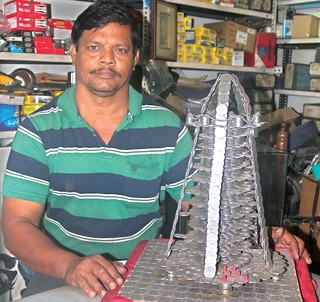 Have you seen the Petronas Twin Towers made with old coins? Or the Leaning Tower of Pisa made with a stack of old aluminum 10 Paisa coins?
S Hunsuldeen of Saligramam hasn’t just seen the creations, he has made them come alive. Among the hundreds of coin collectors in Chennai, Hunsul, a
mechanic, coin collector and miniature coin-building maker, stands apart.
Have you seen the Petronas Twin Towers made with old coins? Or the Leaning Tower of Pisa made with a stack of old aluminum 10 Paisa coins?
S Hunsuldeen of Saligramam hasn’t just seen the creations, he has made them come alive. Among the hundreds of coin collectors in Chennai, Hunsul, a
mechanic, coin collector and miniature coin-building maker, stands apart.
“My love for coins began when I was a teenager. I used to watch my father Sheik Udman collect coins in a glass jar. That inspired me, and I started pursuing it as a hobby,” says the 50-year-old
After almost 37 years of coin collecting, what are his most prized possessions? There is a sense of accomplishment in his tone when he says, “I have coins that date back to the Raja Raja Chola era, Mughal era and Modern India.” He shows us his collection of coins released during the rule of Tipu Sultan, Akbar and Shah Jahan. “Recently I collected 100-rupee coins from 1959. Till today, I have over 89 sets of 100-rupee coins,” he shares.
So why did he start making miniature buildings with coins? “Many people collect coins but I wanted to do something unique. I asked my children to browse the net and check if there were people who made miniature buildings out of coins. There weren’t many,” he says. He started out building the world cup and then moved on to making the Petronas Twin Towers, the Leaning Tower of Pisa, and local monuments like the Anna Tower, Gandhi Mandapam, and Ashok Pillar.
Does this coin-architect have a larger dream? “I want to build the Seven Wonders of the World, and create a Guinness world record,” he smiles. He is currently working on a structure of the Taj Mahal.
To read the complete article, see:
'I
Want to Build Seven Wonders of the World'
(www.newindianexpress.com/cities/chennai/I-Want-to-Build-Seven-Wonders-of-the-World/2015/12/17/article3181067.ece)

